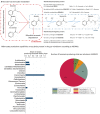NMR Metabolomics Reveal Urine Markers of Microbiome Diversity and Identify Benzoate Metabolism as a Mediator between High Microbial Alpha Diversity and Metabolic Health
- PMID: 35448495
- PMCID: PMC9025190
- DOI: 10.3390/metabo12040308
NMR Metabolomics Reveal Urine Markers of Microbiome Diversity and Identify Benzoate Metabolism as a Mediator between High Microbial Alpha Diversity and Metabolic Health
Abstract
Microbial metabolites measured using NMR may serve as markers for physiological or pathological host-microbe interactions and possibly mediate the beneficial effects of microbiome diversity. Yet, comprehensive analyses of gut microbiome data and the urine NMR metabolome from large general population cohorts are missing. Here, we report the associations between gut microbiota abundances or metrics of alpha diversity, quantified from stool samples using 16S rRNA gene sequencing, with targeted urine NMR metabolites measures from 951 participants of the Study of Health in Pomerania (SHIP). We detected significant genus-metabolite associations for hippurate, succinate, indoxyl sulfate, and formate. Moreover, while replicating the previously reported association between hippurate and measures of alpha diversity, we identified formate and 4-hydroxyphenylacetate as novel markers of gut microbiome alpha diversity. Next, we predicted the urinary concentrations of each metabolite using genus abundances via an elastic net regression methodology. We found profound associations of the microbiome-based hippurate prediction score with markers of liver injury, inflammation, and metabolic health. Moreover, the microbiome-based prediction score for hippurate completely mediated the clinical association pattern of microbial diversity, hinting at a role of benzoate metabolism underlying the positive associations between high alpha diversity and healthy states. In conclusion, large-scale NMR urine metabolomics delivered novel insights into metabolic host-microbiome interactions, identifying pathways of benzoate metabolism as relevant candidates mediating the beneficial health effects of high microbial alpha diversity.
Keywords: NMR metabolomics; alpha diversity; benzoate metabolism; large cohort data; microbiome.
Conflict of interest statement
The authors declare no conflict of interest. The funders had no role in the design of the study; in the collection, analyses, or interpretation of data; in the writing of the manuscript; or in the decision to publish the results. H.J.G. has received travel grants and speakers honoraria from Fresenius Medical Care, Neuraxpharm, Servier, and Janssen Cilag. A.P. has received lecturer honoraria from Technopath Clinical Diagnostics, Tosoh Bioscience, Roche Diagnostics, Beckmann Coulter GmbH, and Radiometer. M.N. has received travel grants by German Medical Association, German Centre for Cardiovascular Research, German Society for Clinical Chemistry and Laboratory Medicine, German National Cohort, German Research Foundation, Deutsche Akkreditierungsstelle, Sysmex, MDI Limbach, medpoint GmbH and Diasys; speaker’s honoraria from Novartis Pharma, Radiometer, AstraZeneca, Technopath Clinical Diagnostics, Sysmex, MDI Limbach, and medpoint Medizinkommunikations GmbH; and research funding from Aerocom GmbH and Profil Institut für Stoffwechselforschung GmbH.
Figures




Similar articles
-
Human and preclinical studies of the host-gut microbiome co-metabolite hippurate as a marker and mediator of metabolic health.Gut. 2021 Nov;70(11):2105-2114. doi: 10.1136/gutjnl-2020-323314. Epub 2021 May 11. Gut. 2021. PMID: 33975870 Free PMC article.
-
Associations between untargeted plasma metabolomic signatures and gut microbiota composition in the Milieu Intérieur population of healthy adults.Br J Nutr. 2021 Oct 14;126(7):982-992. doi: 10.1017/S0007114520004870. Epub 2020 Dec 10. Br J Nutr. 2021. PMID: 33298217
-
Network of Interactions Between Gut Microbiome, Host Biomarkers, and Urine Metabolome in Carotid Atherosclerosis.Front Cell Infect Microbiol. 2021 Oct 7;11:708088. doi: 10.3389/fcimb.2021.708088. eCollection 2021. Front Cell Infect Microbiol. 2021. PMID: 34692558 Free PMC article.
-
Metabolomics approaches for characterizing metabolic interactions between host and its commensal microbes.Electrophoresis. 2013 Oct;34(19):2787-98. doi: 10.1002/elps.201300017. Epub 2013 Aug 16. Electrophoresis. 2013. PMID: 23775228 Review.
-
Gut metabolome meets microbiome: A methodological perspective to understand the relationship between host and microbe.Methods. 2018 Oct 1;149:3-12. doi: 10.1016/j.ymeth.2018.04.029. Epub 2018 Apr 30. Methods. 2018. PMID: 29715508 Review.
Cited by
-
Reducing Mass Confusion over the Microbiome.Anal Chem. 2023 Nov 21;95(46):16775-16785. doi: 10.1021/acs.analchem.3c02408. Epub 2023 Nov 7. Anal Chem. 2023. PMID: 37934885 Free PMC article.
-
Strongyloides stercoralis infection induces gut dysbiosis in chronic kidney disease patients.PLoS Negl Trop Dis. 2022 Sep 6;16(9):e0010302. doi: 10.1371/journal.pntd.0010302. eCollection 2022 Sep. PLoS Negl Trop Dis. 2022. PMID: 36067216 Free PMC article.
-
The Effects of Hospitalisation on the Serum Metabolome in COVID-19 Patients.Metabolites. 2023 Aug 16;13(8):951. doi: 10.3390/metabo13080951. Metabolites. 2023. PMID: 37623894 Free PMC article.
-
Biological Magnetic Resonance Data Bank.Nucleic Acids Res. 2023 Jan 6;51(D1):D368-D376. doi: 10.1093/nar/gkac1050. Nucleic Acids Res. 2023. PMID: 36478084 Free PMC article.
-
Metabolomic Study of Aging in fa/fa Rats: Multiplatform Urine and Serum Analysis.Metabolites. 2023 Apr 12;13(4):552. doi: 10.3390/metabo13040552. Metabolites. 2023. PMID: 37110210 Free PMC article.
References
Grants and funding
LinkOut - more resources
Full Text Sources

